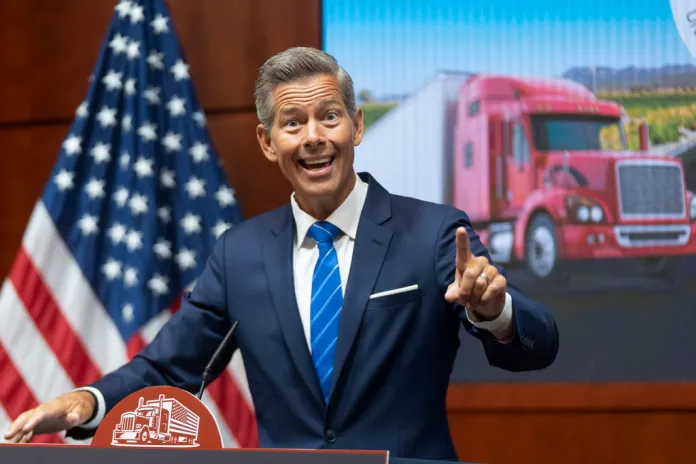Transportation Secretary Sean Duffy is moving to rewrite decades of federal rules, a sweeping deregulation drive that his allies call overdue modernization and safety advocates warn could cut too deep.
According to figures shared exclusively with the Washington Examiner, the Department of Transportation has carried out 157 deregulatory actions, cutting more than 140,000 words from the Federal Register and claiming about $1.3 billion in cost savings. Officials said each change was vetted by the department’s Regulatory Reform Task Force to ensure safety “is never compromised.”
One senior official described the process as “clearing the underbrush,” scrapping rules written decades ago that no longer match today’s technology. Some requirements, the official noted, referred to equipment “that doesn’t even exist anymore.”
Among the most visible reversals are in trucking and auto regulation. The Federal Motor Carrier Safety Administration and National Highway Traffic Safety Administration withdrew a proposal to require speed-limiting devices on heavy trucks, saying the rule lacked a compelling safety rationale. Another FMCSA initiative deleted 1,800 words of redundant text and wiped out nearly 25,000 violations the agency called unnecessary paperwork. The department decided not to require electronic logging devices on trucks built before 2000, citing technical limitations, and has stepped up enforcement against illegal double brokering, a practice in which freight loads are transferred to other carriers without authorization.
The deregulatory campaign also includes a reset of federal fuel economy standards, with DOT arguing that the previous administration “ignored statutory requirements” by factoring in electric vehicles when setting benchmarks. Speaking at a Politico Live event, Deputy Secretary Steve Bradbury said the new rule “resets” the Corporate Average Fuel Economy program in line with congressional intent. “We’re going to make sure standards are realistic for internal-combustion and diesel-powered vehicles,” he said.
The department has also sought to speed up environmental reviews for major infrastructure projects, approving a first-of-its-kind agreement with Texas to give the state more control over federal environmental reviews under the National Environmental Policy Act. Instead of waiting on Washington, Texas will now handle certain federal responsibilities, a model officials say can speed up infrastructure work while preserving key environmental safeguards. A similar deal with Connecticut streamlines historic preservation reviews, and other states are exploring comparable partnerships.

The American Public Transportation Association praised Secretary Duffy’s early efforts to cut “needlessly duplicative” rules that slow down major projects. APTA President and CEO Paul Skoutelas said the association has urged DOT to align the NEPA projects with the faster procedures used on the highway side, where agencies can self-certify certain environmental exclusions.
“There’s no reason transit projects should face more onerous requirements than highways,” he told the Washington Examiner. “Streamlining NEPA reviews would save time and money while maintaining the same environmental protections.”
At the Governors Highway Safety Association, Senior Director Daniel Zimmerman said state offices have seen benefits from the administration’s early steps to reduce administrative burdens tied to highway-safety grants. But he cautioned that efficiency must not come at the expense of oversight.
“There needs to be a balance between appropriate oversight, making sure the funds are used as Congress intended, but also making sure there’s not so much administrative requirement that it’s actually impacting states’ ability to be effective in the programs they’re delivering,” Zimmerman said. “States are at a point where they’ve had to defer resources that would normally be going to safety programs just to meet these administrative requirements in the past.”
The department’s deregulatory posture has also extended to federal grantmaking. Early in his tenure, Duffy rescinded $4 billion from California’s long-delayed high-speed rail project, a move officials said underscored the administration’s intent to focus on viable projects that deliver results.
“The California high-speed rail boondoggle was never going to happen,” a senior DOT official said. “Not a single track was laid down in sixteen years. The Secretary recognized that taxpayers work too hard for $4 billion of their dollars to go down the drain.”
DOT officials said the withdrawn funds will be redirected to “viable and meritorious passenger-rail projects that actually deliver for the American people.” The department, they added, is prioritizing “updating roads and bridges and our ports and our rail systems, fundamental core infrastructure.”
The move reflects Duffy’s broader philosophy: scaling back federal involvement in projects he sees as wasteful while giving states and industries more flexibility to move faster. However, that approach has sparked concern among some safety and advocacy groups, who fear that the department could move too quickly.
“Certainly time has rendered some regulations obsolete,” said Zach Cahalan, executive director of the Truck Safety Coalition, which represents families of crash victims, speaking to FreightWaves. “However, TSC remains concerned FMCSA is rushing to fulfill campaign pledges and failing to uphold its historically high burden to prove any deregulatory changes will not adversely impact safety.”
Cahalan noted a proposal that would scrap the rule requiring older trailers, those made before 1993, to have reflective tape to make them more visible at night. He criticized the agency for assuming those trailers are no longer on the road without offering any data to back that up.
DUFFY BLAMES DEMOCRATS FOR DELAYED TRAVEL ‘CHAOS’ DURING PROLONGED SHUTDOWN
DOT officials reject the notion that deregulation means lowering standards. “We review each regulation meticulously to ensure safety is never compromised,” a spokesperson said.
They added that more reforms are on the way, including updates for rail, maritime, and emerging vehicle technologies, in part of what they describe as a long-term push to bring Washington’s transportation rulebook into the twenty-first century.
